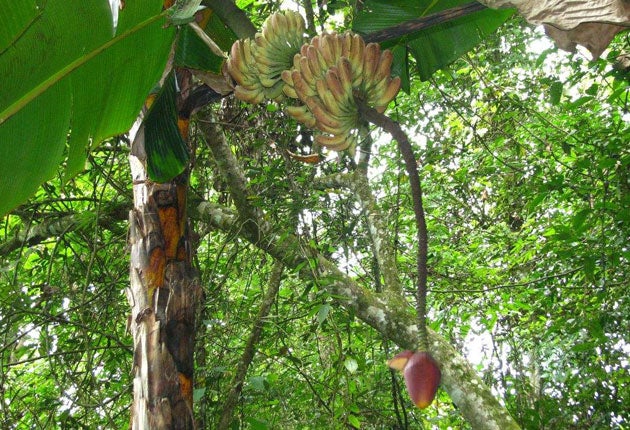24,200 down, 217,800 to go: why the pink banana is a coup for Kew
Royal Botanic Gardens hits 10 per cent in quest to collect seeds of world's plants

A pink banana marks a milestone today, as Kew Gardens celebrates collecting the seeds of 10 per cent of the world's wild plants.
The banana in question, the Yunnan banana, Musa itinerans, found in Asia from China to India, is the 24,200th species to be conserved for Kew's Millennium Seed Bank, and as such denotes the 10 per cent mark in Kew's mammoth task of collecting and preserving the world's wild seeds, which it took up in 2000.
It is 24,200 down and 217,800 to go in what is perhaps the most ambitious botanical project anywhere – that of fending off the multiple threats of extinction hanging over the flowering plants of the world, of which 70 per cent are now at risk.
Collecting their seeds is an insurance against future disasters, as Kew scientists believe many will be capable of germination hundreds of years from now, once they are dried and stored at 20 degrees below zero at the £80m seed bank, located at the Royal Botanic Gardens' outstation at Wakehurst Place in Sussex.
Botanical bodies from more than 50 countries have joined in a global partnership with Kew to facilitate the collection exercise. The seeds of the Yunnan banana were gathered in south-west China by the Kunming Institute of Botany, which is part of the Chinese Academy of Sciences.
The case of Musa itinerans shows precisely why the seed bank matters. The banana is an important staple food for wild Asian elephants and other wildlife. And its young flowers and stem are made into popular dishes in southern Chinese restaurants. Although the fruit is not itself a major food crop for humans, it represents an important genetic resource for the tropical fruits industry, as it is a wild crop relative that can be used to breed new banana varieties that have disease resistance and other such traits.
Yet it is increasingly under threat in the wild, as its tropical forest habitat is cleared for agriculture.
Many valuable and potentially valuable plants, especially in poorer regions of the world, are at risk from causes ranging from development to drought and the spread of deserts. In setting up the seed bank, Kew's scientists estimated that as many as a quarter of species might be facing extinction by mid-century. Some of the seeds they hold are from plants already extinct in the wild, such as the spiny everlasting, a vanished shrub from South Australia.
The target was to collect 10 per cent of the world's wild seeds by 2010 and 25 per cent by 2025 – now brought forward to 2020. Reaching the 10 per cent mark ahead of schedule is a remarkable achievement and today it will be celebrated with a ceremony at Wakehurst Place hosted by Kew's director, Professor Stephen Hopper, and attended by representatives of 52 of Kew's partner institutions from 27 countries.
"The success we are celebrating is extraordinary and on a scale never before contemplated in global biodiversity conservation," said Professor Hopper. "In a time of increasing concern about loss of biodiversity and climate change, the need for the kind of insurance policy and practical conservation resource the Millennium Seed Bank provides has never been greater."
The seed bank was "not a doomsday vault where seeds are stored under lock and key," said Dr Paul Smith, the head of the partnership. "Our mission is to use these seeds to support conservation and improve people's lives."
National treasures: Britain's wild flowers
Asian bananas, of course, are not the only focus of the Millennium Seed Bank. Its vast collection includes the seeds of nearly all of Britain's wild flowers, in what is thought to be the most comprehensive compilation of any national flora.
Britain has about 1,440 native plants (the precise figure is constantly changing as species are reclassified) and the seed bank's UK Flora Project has gathered in the seeds of all but about 60 of them – more than 95 per cent – according to its co-ordinator, Steve Alton.
They range from our most common plants, such as the stinging nettle and annual meadow-grass, to what may be the rarest, the lady's slipper orchid, which until the last few years was down to a single clump in Yorkshire. Seeds still missing come from plants that are found only in particularly remote or difficult-to-access places, such as alpine rock-cress, found at a single site high on a mountain on the Isle of Skye, or from plants which are extremely similar and can only be told apart by experts, such as some of the eyebrights.
Many of the seeds were collected by volunteers, amateur botanists who roamed the countryside. But recently, collecting the seeds of the more difficult plants has become the province of professionals.
Mr Alton is hoping to do one final collecting push, using volunteers, but feels that to gather the seeds from every British plant may ultimately be an impossibility, as some of them, such as some of the sedges, do not set seed at all but propagate by sprouting runners underground.
Join our commenting forum
Join thought-provoking conversations, follow other Independent readers and see their replies
Comments